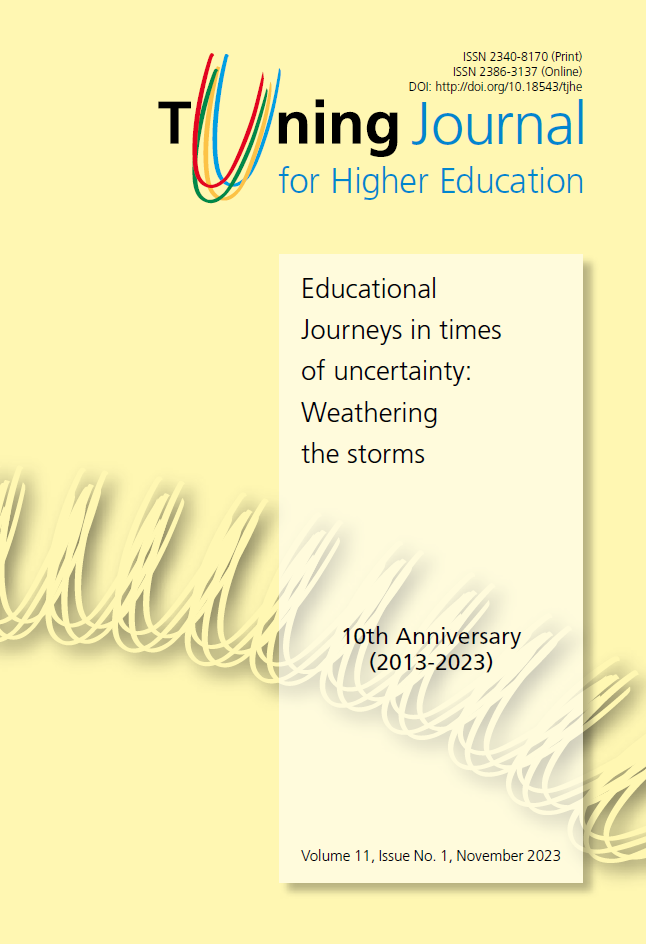Analysis of Engineering students’ errors and misunderstandings of integration methods during the COVID-19
Abstract
The prevalence of the COVID-19 pandemic and its consequences, such as the closure of educational centers and the requirement to use virtual education, have all challenged students’ learning. Students’ mathematical misunderstandings can be regarded as one such challenge. While such problems may also occur in face-to-face training, where teachers and educators are involved, it seems that this problem is more serious in virtual education. The purpose of the present study was to investigate students’ misunderstandings in regard to integration methods. More specifically, the statistical population of this study consisted of engineering students from Islamic Azad University. The sample members included 40 students from the faculty of engineering who had been taught Mathematics1 by virtual education in the first semester of the academic year 2021-2022. To conduct this research, students were taught different methods of integration in cyberspace for six consecutive weeks. During these six stages, tests were conducted online to assess students. The results showed that most of the students’ errors were conceptual and computational in nature; they were rooted in no suitable understanding of the basic concepts of mathematics and the lack of good education in high school.
Received: 3 May 2022
Accepted: 15 April 2023
Downloads
References
Aghazadeh, Moharram, and Moharram Naghizadeh. 2010. TIMSS Understanding, International Study of Students’ Academic Achievement in Mathematics and Science. [In Persian.] Tehran: Institute of Meraat, Schools that learn.
Agustyaningrum, N., A. M. Abadi, R. N. Sari, and A. Mahmudi. 2018 “An Analysis of Students’ Error in Solving Abstract Algebra Tasks.” Journal of Physics: Conference Series 1097, no. 1: 012118. https://doi.org/10.1088/1742-6596/1097/1/012118.
Alamolhodaei, Seyed Hassan. 2015. Principles of Mathematics Education. [In Persian.] 3rd ed. Mashhad: Ferdowsi University Press.
Bakhshalizadeh, Shahrnaz, and Nasser Broojerdian. 2018. “Identifying the Primary School Fourth-grade Students’ Common Misconceptions in the Content Area of Geometry and Measurement: A Comparison of their Performance with the Mean Performance at International Level.” [In Persian.] Educational Innovation 16, no. 4: 101-126
Bezuidenhout, Jan. 2001. “Limits and Continuity: Some Conceptions of First-year Students.” International Journal of Mathematical Education in Science and Technology 32, no. 4: 487-500. https://doi.org/10.1080/00207390010022590.
Dane, Arif, Ömer Faruk Çetin, Fatih Bas, and Meryem Özturan Sagirli. 2016. “A Conceptual and Procedural Research on the Hierarchical Structure of Mathematics Emerging in the Minds of University Students: An Example of Limit-Continuity-Integral-Derivative.” International Journal of Higher Education 5, no. 2: 82-91. https://doi.org/10.5430/ijhe.v5n2p82.
Dogrucan, Harun, Danyal Soybas, and Sevim Sevgi. 2020. “The Investigation of Middle School Student Learning Difficulties and Concept Misunderstandings in Multipliers and Factorization.” Excellence in Education Journal 9, no. 3: 109- 144. https://files.eric.ed.gov/fulltext/EJ1284653.pdf.
Ebrahimi Sadrabadi, Zahra, and Leila Mohammadnia. 2018. “Provide an Active Teaching Method to Reduce Eighth-grade Geometric Misunderstandings.” [In Persian.] Paper presented at The 16th Iranian Mathematics Education Conference., Jul 31- Aug 3, Mazandaran, Iran.
Fuadiah, Nyiayu Fshirza, Didi Suryadi, and Turmudi Turmudi. 2019. “Teaching and Learning Activities in Classroom and Their Impact on Student Misunderstanding: A Case Study on Negative Integers.” International Journal of Instruction 12, no. 1: 407-424. https://doi.org/10.29333/iji.2019.12127a.
Haghkhah, Sareh and Azar Davoudi. 2021. “Strategies for Preventing and Correcting Mathematical Misunderstandings (a Qualitative Study).” [In Persian.] Journal of Education in Basic Sciences 6, no. 21: 24-37.
Hashemi, Nourooz, Mohd Salleh Abu, Hamidreza Kashefi, Mahani Mokhtar, and Khadijeh Rahimi. 2015. “Designing Learning Strategy to Improve Undergraduate Students’ Problem-solving in Derivatives and Integrals: A Conceptual Framework.” Eurasia Journal of Mathematics, Science and Technology Education 11, no. 2: 227-238. https://doi.org/10.12973/eurasia.2015.1318a.
Holmes, Vicki-Lynn, Chelsea Miedema, Lindsay Nieuwkoop, and Nicholas Haugen. 2013. “Data-Driven Intervention: Correcting Mathematics Students’ Misconceptions, not Mistakes.” The Mathematics Educator 23, no. 1: 24-44.
Iyer, Parvati, Kalid Aziz, and David M. Ojcius. 2020. “Impact of COVID-19 on Dental Education in the United States.” Journal of Dental Education 84, no. 6: 718-722. https://doi.org/10.1002/jdd.12163.
Karimzadeh, Roya, and Mahdieh Abbasloo. 2017. “The Role of Teachers in Correcting Students’ Mathematical Misunderstandings.” [In Persian.] Paper presented at “The Provincial Scientific Research Conference on Strategies and Solutions to Improve Quality in Education.” Dec 22, 2017, Minab, Iran.
Legutko, Maria. 2008. “An Analysis of Students’ Mathematical Errors in the Teaching-Research Process.” In Handbook of Mathematics Teaching Research: Teacher Experiment -A Tool for Teacher-Researchers. edited by Bronisław Czarnocha, Poland: Drukarnia Cyfrowa KSERKOP. University of Rzeszów: 141-152.
Marks, Rick. 1990. “Pedagogical Content Knowledge: From a Mathematical Case to a Modified Conception.” Journal of Teacher Education 41, no. 3: 3-11. https://doi.org/10.1177/002248719004100302.
Muzangwa, Jonatan, and Peter Chifamba. 2012. “Analysis of Errors and Misconceptions in the Learning of Calculus by Undergraduate Students.” Acta Didactica Napocensia 5, no. 2: 1-10. https://eric.ed.gov/?id=EJ1054301.
Pepper, Rachel E., Stephanie V. Chasteen, Steven J. Pollock, and Katherine K. Perkins. 2012. “Observations on Student Difficulties with Mathematics in Upper-division Electricity and Magnetism.” Physical Review Special Topics –Physics Education Research 8, no. 1: 010111. 8 (1): 010111-1-15. https://doi.org/10.1103/PhysRevSTPER.8.010111.
Perkins, David. N., and Rebecca Simmons. 1988. “Patterns of Misunderstanding: An Integrative Model for Science, Math, and Programming.” Review of Educational Research 58, no. 3: 303-326. https://doi.org/10.3102/00346543058003303.
Saffari, Roya. 2017. “Investigating the Reduction of Students’ Conceptual Mistakes in the Topic of Trigonometry with Emphasis on the Role of Animations.” [In Persian.] Paper presented at “The first National Conference of Mathematics and Statistics.” Feb 16, 2017, Shiraz, Iran.
Şahin, Zülal, Arzu Aydogan Yenmez, and Ayhan Kursat Erbas. 2015. “Relational Understanding of the Derivative Concept through Mathematical Modeling: A Case Study.” Eurasia Journal of Mathematics, Science and Technology Education 11, no. 1: 177-188. https://doi.org/10.12973/eurasia.2015.1149a.
Shahvarani, Ahmad, Mohammad Hasan Behzadi, and Abed Moradi. 2013. “Misconceptions of Students about Comparing Decimal Numbers from 6th, 7th and 8th Year of Girl Pishva Town.” [In Persian.] Quarterly Journal of Educational Psychology 5, no. 4: 61-75.
Shamsuddin, Maisurah, Siti Balqis Mahlan, Norazah Umar, and Fadzilawani Astifar Alias. 2015. “Mathematical Errors in Advanced Calculus: A Survey Among Engineering Students.” ESTEEM 11, no. 2: 37-44. https://ir.uitm.edu.my/id/eprint/15309.
Smith III, John P., Andrea A. DiSessa, and Jeremy Roschelle. 1994. “Misconceptions Reconceived: A Constructivist Analysis of Knowledge in Transition.” The Journal of the Learning Sciences 3, no. 2: 115-163. https://doi.org/10.1207/s15327809jls0302_1.
Sofronas, Kimberly S., Thomas C. DeFranco, Charles Vinsonhaler, Nicholas Gorgievski, Larissa Schroeder, and Chris Hamelin. 2011. “What Does It Mean for a Student to Understand the First-Year Calculus? Perspectives of 24 Experts.” The Journal of Mathematical Behavior 30, no. 2: 131-148. https://doi.org/10.1016/j.jmathb.2011.02.001.
Son, Ji-Won. 2013. “How Preservice Teachers Interpret and Respond to Student Errors: Ratio and Proportion in Similar Rectangles.” Educational Studies in Mathematics 84, no. 1: 49-70. https://doi.org/10.1007/s10649-013-9475-5.
Tadesse, Seble, and Worku Muluye. 2020. “The Impact of COVID-19 Pandemic on Education System in Developing Countries: A Review.” Open Journal of Social Sciences 8, no. 10: 159-170. https://doi.org/10.4236/jss.2020.810011.
Tall, David. 2011. “Looking for the Bigger Picture.” For the Learning of Mathematics 31, no. 2: 17-18. https://flm-journal.org/Articles/59094BCBBF38177DB99C3649BA79A8.pdf.
Voon, Li Li, Nor Hazizah Julaihi, and Howe Eng Tang. 2017. “Misconceptions and Errors in Learning Integral Calculus.” Asian Journal of University Education (AJUE) 13, no. 1: 17-39. https://ir.uitm.edu.my/id/eprint/21914/1/AJ_VOON%20LI%20LI%20AJUE%2017.pdf.
Authors are required to sign and submit a copyright transfer agreement after acceptance but before publication of their manuscript. To that effect, they receive, from the Managing Editor of Tuning Journal for Higher Education, a standard copyright assignment form designed along the following lines:
1. Authorship:
The author who signs the copyright transfer agreement must be the sole creator of the work or legally acting on behalf of and with the full agreement of all the contributing authors.
2. Copyright and Code of conduct:
a) Authors warrant that their work is original; has not been previously copyrighted or published in any form; is not under consideration for publication elsewhere; its submission and publication do not violate TJHE Ethical Guidelines for Publication and any codes (of conduct), privacy and confidentiality agreements, laws or any rights of any third party; and no publication payment by the Publisher (University of Deusto) is required.
b) Authors are solely liable for the consequences that may arise from third parties’ complaints about the submitted manuscript and its publication in Tuning Journal for Higher Education (TJHE).
c) Authors grant to the Publisher the worldwide, sub-licensable, and royalty-free right to exploit the work in all forms and media of expression, now known or developed in the future, for educational and scholarly purposes.
d) Authors retain the right to archive, present, display, distribute, develop, and republish their work (publisher's version) to progress their scientific career provided the original publication source (Tuning Journal) is acknowledged properly and in a way that does not suggest the Publisher endorses them or their use of the wortk.
e) Authors warrant that no permissions or licences of any kind will be granted that might infringe the rights granted to the Publisher.
3. Users:
Tuning Journal for Higher Education is an Open Access publication. Its content is free for full and immediate access, reading, search, download, distribution and reuse in any medium or format only for non-commercial purposes and in compliance with any applicable copyright legislation, without prior permission from the Publisher or the author(s). In any case, proper acknowledgement of the original publication source must be made and any changes to the original work must be indicated clearly and in a manner that does not suggest the author’s and or Publisher’s endorsement whatsoever. Any other use of its content in any medium or format, now known or developed in the future, requires prior written permission of the copyright holder.


1.jpg)
1.jpg)
.jpg)
1.jpg)
.jpg)
.jpg)









